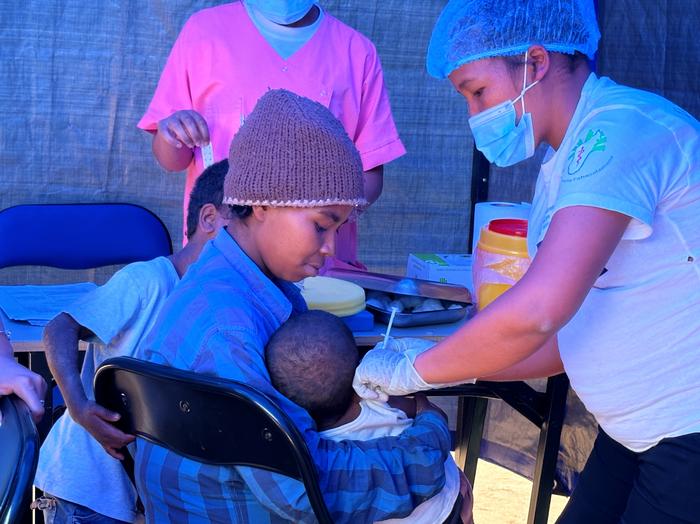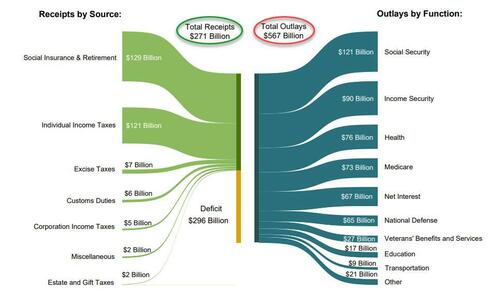Authored by Victor Davis Hanson via AmGreatness.com,
Yes, there is a way. But is there the will?
Most Americans know something has gone terribly wrong—and very abruptly—with the United States. They are certain that our wounds are almost all self-inflicted. The current pathologies are not a result of a natural disaster, an exhaustion of natural resources, plagues, or an existential war.
Crushing national debt and annual deficits, spiraling food and fuel costs amid “normal” seven-percent-plus annual inflation, bread-and-circuses entitlements, a nonexistent border, a resurgence of racial tribalism, pandemic violent criminality, and humiliation abroad—all these pathologies are easily cited as symptoms of a sick patient. Our crises are not as the Left maintains—a nine-person Supreme Court, the Electoral College, or the filibuster—all distractions from existential problems the Left largely created.
So, what are the therapies and prognoses for America?
In the spirit of constructive rather than blanket criticism, here is a partial, 10-point plan of national recovery.
1. Cut the Debt
Americans’ national debt is now $31 trillion. That is about 123 percent of current GDP. The liabilities are unsustainable. We run annual deficits of $1.6 trillion. These financial obligations will eventually ensure that rising interest rates to service the debt crowd out essential spending for national defense and the general welfare.
Or in extremis, in the not too distant future, the government will be forced to default on what it owes the “rich” bondholders and foreign debt holders. Or the government will be forced to confiscate private wealth, as for example occasional crazy suggestions to nationalize and absorb 401(k)k retirement plans into the soon-to-be-insolvent Social Security system. Or the state will simply print millions of dollars to pay off obligations, Weimar-style.
In addict style, the more we come to realize that our binging habit cannot go on, the less we can practice self-restraint. And the more it is the case that those who receive government redistributions outnumber those who pay the majority of federal income taxes, the less hope there remains to avoid insolvency.
In 2010 then-President Barack Obama appointed a bipartisan “National Commission on Fiscal Responsibility and Reform.” More commonly remembered as the Simpson-Bowles commission, after chairmen Senators Alan Simpson (R-Wyo.) and Erskine Bowles (D-N.C.), it included private citizens and elected officials.
The commission recommended radical tax simplifications and some cuts—along with reductions in tax deductions and credits, an increase in the gas tax, restraints on entitlement spending, and various spending caps.
Obama and Congress ultimately rejected the recommendations and the commission’s blueprint died. But had it succeeded, the current debt would have long been frozen at the 2014 level of $17 trillion—with annual reductions ensuring that this coming year 2023 the debt would have plunged to $10 trillion and then disappeared in another decade.
Something like Simpson-Bowles could still stop the madness and avoid the natural corrective on the horizon of financial collapse. Note that federal tax revenue has increased almost every year since 2010. Sometimes it grows by nearly a half-trillion dollars per annum, even as we sink deeper in debt. Our crisis, then, is one of spending what we do not have rather than one of declining revenue.
2. Secure the Border
We no longer have a southern border. There have been 5 million illegal border crossings just since Joe Biden took office. He intentionally destroyed immigration law for cheap political advantage. Nearly 50 million current American residents were not born in the United States. Well over 20 million—and perhaps 30 million—are illegal aliens. Old melting-pot efforts at assimilation and integration eroded into the salad-bowl metaphor that has just become tribalism—even as intermarriage is at an all-time high.
The Left brags that “demography is destiny” as it cheers the changes in the electorate aimed at ensuring its political dominance. And simultaneously, it smears conservatives who agree with its triumphalism as “great replacement theory” conspiracists.
Yet we finally found a solution in 2019-2020. Had we continued replacing rickety border fencing with an effective wall and then completed it along the entire border, had we stopped catch-and-release, had we continued demanding that refugee status be obtained before entry, had we forced Mexico and Central American governments to stop exporting human capital and subjected them to taxes on more than $60 billion in annual remittances (along with trade penalties) for their complicity with the situation at the border, had we continued to deport those who entered illegally, had we returned to assimilation and integration on the theory any who entered America did so because they wanted to become Americans, then a desired legal, meritocratic, and diverse immigration policy might easily have assimilated and absorbed perhaps 200,000 skilled and legal immigrants per year.
Again, we had the outlines of a solution and then simply destroyed it for liberal political agendas and cheap corporate labor.
3. Tap Natural Resources
Similarly, by 2020, the United States enjoyed inexpensive fuel. It was all but independent in gas and oil. It had become the world largest combined gas and oil producer. That status radically curtailed the need for optional military engagements in the Middle East. It gave America enormous clout against hostile oil exporters like Russia, Iran, and Venezuela. And such independence helped reduce vast trade deficits.
Again, the Biden Administration simply exploded the idea of fossil-fuel independence as a gradual transition to sustainable energy. So simply doing the opposite of its policies would correct the pathology almost immediately: Issue more federal gas and oil leases, approve the Keystone and Constitution pipelines, reopen the Arctic National Wildlife Reserve, and build nuclear power plants. The present course of high-priced and scarce gasoline and oil is eroding the middle class, spiking inflation, widening class divisions, and reducing American autonomy abroad.
4. Oppose Discrimination
Never has the United States seen more evidence of progress in racial relations, and never has such progress given way to more tribalism. If we do not return to a Martin Luther King, Jr. “content of our character” policy—one that views race as incidental rather than essential to who we are—then our future is a sectarian one with echoes of the former Yugoslavia, Rwanda, and Iraq.
Affirmative action was never envisioned as permanent quotas and race-based reverse-discrimination. Yet after over a half-century it has ballooned under the idea of “diversity” to invent a victim class of nearly a third of the nation, absurdly and loosely defined—in an age of commonplace intermarriage—as “non-white.”
Help for the underprivileged should be race-neutral and entirely based on class and income, given numerous ethnicities exceed the so-called white medium income. The labyrinth of racial categories grows unfathomable. The identity politics mess logically results, on the one hand, with rank iconic frauds like Elizabeth Warren, Ward Churchill, and Rachel Dolezal, and, the other hand, with well-off poseur victims in the manner of a Meghan Markle, Colin Kaepernick, or Jussie Smollett.
Substitution of racial criteria for merit, rather than aiding the poor of all races, is creating a commissar-like drag on the economy, spiking racial and ethnic tensions, and ensuring that every group will eventually, for its survival, go tribal on the basis of the same logic that applies to nuclear proliferation. Again, the remedy? Just enforce civil rights statutes that prohibit racial discrimination and consider the Pavlovian shriek of “racism!” as the revealing projection of racists.
5. Disrupt and Reform Higher Education
Our universities are failing to produce competent graduates essential to a meritocratic nation engaged in fierce global competition. Increasingly, students are politicized, largely ignorant, indebted, bitter, and unable to ensure American preeminence in basic science, technology, engineering, and math.
Yet the solutions are again simple: get the government out of the student-loan business that ensures escalating tuition hikes greater than the rate of inflation. Eliminate faculty tenure and replace it with five-year contracts that require demonstrable achievement. Subject large endowments to taxation on their interest income to curb their wasted spending. Allow public schools to hire either those with school of education credentials or one-year master’s degrees that focused solely on academic study. Require standardized exit tests, in the fashion of erstwhile SAT and ACT entry tests, for the certification of the bachelor’s degree. Force universities to follow the Bill of Rights on campus, regarding due process and freedom of expression.
These are not radical suggestions. Yet the likely fierce faculty opposition to them is proof that the Left envisions higher education as it views Silicon Valley—another private monopoly that helps to maintain political power in lieu of popular support.
6. Revive the Armed Forces
Our military is in dire straits. It is overcommitted, under-resourced, and without any geo-political strategy other than ad hoc responses without defined objectives. It has become politically weaponized and, inevitably, unable to meet recruitment goals. The Pentagon remains obsessed with exorbitantly priced weapons that cannot be produced in sufficient numbers in an age of hostile swarms of cheap, mass-produced drones and thousands of batteries of ground-to-air and shore-to-ship missiles.
Constant profiling, racial, and gender quotas and obsessions over proportional representation and disparate impact increasingly apply to training, education, and promotion—to everything except worries over the disproportionate profile of those killed in battle. The Pentagon has become adept in publishing racial data on every aspect of military service to emphasize disparity and bias—except concerning the combat dead.
To address the changes, retiring high-ranking officers should refrain from board memberships on contracting corporations for at least five years upon leaving the military. The uniform code of military justice must be strictly enforced, including article 88 which prohibits retired officers from attacking in personal terms high-ranking elected officials, and in particular their commander-in-chief.
Woke training is destroying morale and battlefield efficacy. The military must return to a race and gender neutral stance that does not erode meritocratic standards to fit political agendas. We should never again witness a chairman of the Joint Chiefs of Staff virtue signaling to Congress and the nation his intention to understand “white rage” in the ranks, without supplying any confirmatory evidence or data for his apparent allegation of systemic racism in the ranks—particularly not while the greatest U.S. defeat and humiliation in a half-century was unfolding on the horizon in Kabul. Any high-ranking military officer who informs his Chinese counterpart of his own psychiatric diagnosis that his commander-in-chief is unhinged and thus U.S. strategic intentions will first be relayed to Beijing should be summarily dismissed.
7. Fix Voting
Elections are a mess. The greatest political revolution in our election history has been the change—accelerated under the cover of COVID and the George Floyd riots—in many key estates from a 20-30 percent “absentee ballot” vote to 70-80 percent early/mail-in balloting. In a mere four years we have all but destroyed Election Day voting and Election Night final tabulations as we had known them for decades.
All discussions of voter IDs, fraud, and charges and countercharges of election denialism are irrelevant if there is no real mechanism to validate the authenticity of mail-in ballots that have incomplete or false addresses, names, and signatures, or do not match registration rolls. Third-party ballot harvesting and ballot curing should be outlawed at the federal level, and we should return to the requirement of requesting absentee ballots rather than automatically sending them out. Otherwise, no future election will again win the confidence of a majority of Americans. And without trust in balloting, consensual government becomes nonexistent.
8. Drain the Swamp
Americans distrust the “swamp,” administrative state, or deep state. Call what you will, the Washington nexus of bureaucracies, media, and lobbyists has created a huge, unelected permanent army of auditors, regulators, investigators, and punishers, all mostly exempt from audit and accountability and without fear of their elected overseers.
The easiest solution is to break up concentrations of power. Transfer out of Washington, in this age of zoom and telecommunications, major cabinet departments like Health and Human Services, Energy, or Agriculture into the hinterland. Restore the idea that lying to Congress, feigning amnesia, or pleading ignorance under oath to Congress or federal investigators or in depositions is a prosecutable felony with jail time.
Had we restored equality under the law, then an Andrew McCabe, James Clapper, and John Brennan would not have dared lie under oath. And a Robert Mueller, James Comey, Anthony Fauci, or Jack Dorsey might have not so easily believed they simply could plead memory loss or mislead in a fashion that no American would dare to do with the IRS.
Being forced to tell the truth would be a powerful deterrent against bureaucratic overreach.
Finally, ossified centralized agencies like the FBI need to be broken up and their bureaus redistributed through the cabinet-level departments to avoid past pathologies resulting from a concentration of power.
9. Upend the Welfare State
The number of those receiving federal and state subsidies is beginning to match the number of those who subsidize them. “No one wants to work anymore” is now a common public lament. Inflation and recession may come and go, but workers are now scarce whether we are in boom or bust times. Labor non-participation remains at an all-time high. Soon only 60 percent of the available labor force will be working. Trillion-dollar COVID subsidies have accelerated the idea that Americans need not work full-time to maintain a living.
We can easily return to the “workfare” championed by a triangulating Bill Clinton in the 1990s that demanded healthy and able recipients to be gainfully employed upon receipt of state and federal cash. In the context of the homeless, we need to return to pre-Reagan norms of institutionalizing the mentally ill and creating hospitals and safe spaces away from American downtowns to house those who either cannot or will not take care of themselves. Defecating, urinating, injecting, and fornicating on city-streets are not victimless crimes, but assaults on civilized life as we once knew it.
10. Restore Norms
Fact is, few public norms are left. Rather than the current therapeutic obsessions that seek to divide Americans into binaries of oppressors and the oppressed, we are in desperate need of civic education in K-12 that acquaints all children and teens with American institutions, key events like Gettysburg or D-Day, and familiarity with the Constitution and the duties of the citizen. We will get nowhere basing our understanding of the world on psychodramas and therapeutics.
Neither journalists nor elites understand, much less appreciate, the First Amendment, and in ignorance despises the Second.
Like it or not, the nuclear family remains the bulwark of the American nation, which will not survive if current fertility rates of below 1.7 children per woman continue to diminish and age the population. The government must incentivize childbearing and child raising.
Without clear punishment for violent crimes, deterrence is lost, and the innocent become victims of the exempt criminal class. Critical race theory, critical legal theory, and critical criminology theory are euphemisms for unleashing lawbreakers upon the vulnerable. We are in a strange cycle in which we deliberately do not enforce gun laws in our cities and then when murder reaches near historic proportions we blame unenforced guns laws rather than the criminals who are exempt in using deadly weapons as the cause.
These are just a few of the many ways that the United States could stop the present madness—which, after all, was entirely self-created.
















































